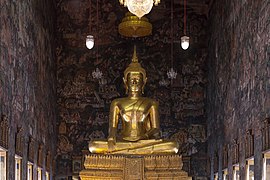| This article needs additional citations for verification. Please help improve this article by adding citations to reliable sources. Unsourced material may be challenged and removed. Find sources: "Maravijaya attitude" – news · newspapers · books · scholar · JSTOR (March 2019) (Learn how and when to remove this message) |

Māravijaya attitude is an attitude of Buddha in Thai art of which the seated Buddha is putting his hand in the relax posture towards to the ground, loosely holding his knee. The other hand is on his lap. His eyes, sometimes closed, look down to the ground. The gesture of the hand reaching the ground is called bhumisparshamudra, which also refers to the attitude as well. The gesture refers to the episode which the Buddha calling the earth to witness.
The attitude refers to the episode that he was reaching the enlightenment and being disturbed by maras. Learning that the maras asked him to give up, he touched the ground and called the Phra Mae Thorani to help him fight with the maras. Thoranee called tonnes of water and flooded away the maras. The episode results in the name Mara Vichai which means the "Victory (vichai) over the Mara". The Māravijaya seated Buddha is considered the common attitude for principal Buddha in ubosots of Khmer, Lao and Thai wats and Burmese kyaungs.

The Dakkhinasakha style of the Buddha in Burmese art features the Buddha in the Māravijaya attitude.
Names
The iconography is known by various names throughout Southeast Asia.
In Burmese art, the attitude is called the bhūmiphassa mudrā (Burmese: ဘူမိဖဿမုဒြာ).
In Khmer art, this attitude of Buddha is called preah pud (buddha) p'chanh mea (Khmer: ព្រះពុទ្ធផ្ចាញ់មារ), which means the sacred buddha defeating the enemy (māra).
In Thai art, this attitude is variously called mara vichai (Thai: ปางมารวิชัย, RTGS: pang manrawichai), Chana Mara (ชนะมาร; victory over the Mara), and Sadoung Mara (สะดุ้งมาร; striking fear into the Mara).
Notable examples
As mentioned, the Māravijaya Buddha is the most commonly-built Buddha, some of the notable Buddharupas in Thailand that are built depicting the Māravijaya are:
- Great Buddha of Thailand
- Phuket Big Buddha
- Golden Buddha of Wat Traimit
- Phra Achana in Sukhothai Historical Park
Gallery
-
Double row of sculpted Buddhas in sanctuary chamber of temple "X" of Preah Pithu, Angkor, Cambodia.
-
 in Phitsanulok province
in Phitsanulok province
-
 at Wat Suthat, Bangkok
at Wat Suthat, Bangkok
-
 Great Buddha of Thailand
Great Buddha of Thailand
-
Phuket Big Buddha
-
 at Wat Xieng Thong, Luang Prabang, Laos
at Wat Xieng Thong, Luang Prabang, Laos
-
 Golden Buddha of Wat Traimit
Golden Buddha of Wat Traimit
References
- "Seated Buddha in". The Walters Art Museum • Works of Art.
- Thai Buddha Attitudes translations
- translated from th:ปางมารวิชัย on Thai Misplaced Pages
External links
 Media related to Category:Bhumisparshamudra at Wikimedia Commons
Media related to Category:Bhumisparshamudra at Wikimedia Commons